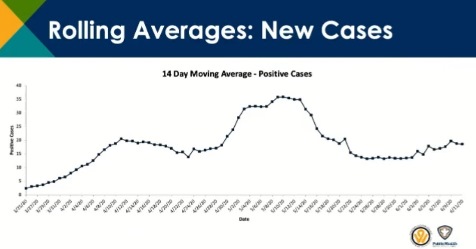
Wyandotte County may not move into the next phase of the reopening plan on June 22 as planned. Local health officials are watching the case numbers, which have increased a bit in recent weeks.
Dr. Allen Greiner, Wyandotte County chief medical officer, said today at a news conference sponsored by the University of Kansas Health System that in the metropolitan area, there is a little bit of an uptick in cases, probably due to the relaxation of ordinances and the phases they have gone through.
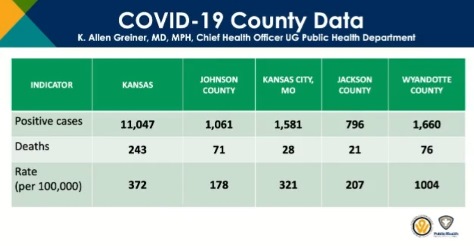
Wyandotte County will likely be staying in Phase 3 at least until June 22, according to a news release from the Health Department, and they are still looking at the figures to determine if the county moves up or down or stays at the same phase.
The rate of positivity in Wyandotte County is still higher than most of the other counties in the metro area, Dr. Greiner said at the news conference.
“We’re still very worried in Wyandotte about what’s going on, and we do have a very vulnerable population,” Dr. Greiner said. “We have a lot of sick folks in Wyandotte, so we want to protect them.”
In the last 10 days there has been an upward trend, and they have seen it in Wyandotte and Johnson counties, he added.
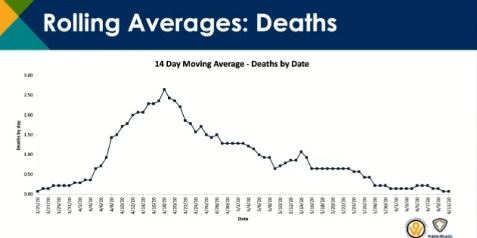
Deaths have been very stable or declining in Wyandotte County over a 14-day average, he said. He added they don’t know why there are less deaths, but they hope that it’s related to the way they’re protecting the most vulnerable, such as those in nursing homes.
Dr. Steve Stites, chief medical officer at KU Health System, said KU Hospital is seeing a little different patient population, patients who are a little younger and who have a little less complex conditions. The length of stay has dropped from 13 to 14 days to seven or eight, he added.
“The hospital numbers here may be a little lower,” he said, “but the number of admissions is up, and the discharges are up.”
There was a slight increase, from 17 on Monday to 19 on Tuesday, of COVID-19 patients at the University of Kansas Health System, according to Dr. Dana Hawkinson, medical director of infection prevention and control at the health system. There were seven patients in the intensive care unit, down from eight on Monday, and five were on ventilators, up from four on Monday.
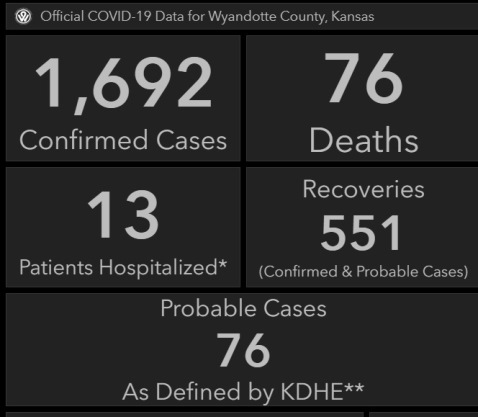
Wyandotte County reported 1,692 positive cases at 1 p.m. Tuesday, an increase of 15 cases since 1 p.m. Monday, according to the UG’s COVID-19 website. The number of deaths were the same.
Dr. Greiner said there has been an effective intervention in the nation, with people protecting the most vulnerable.
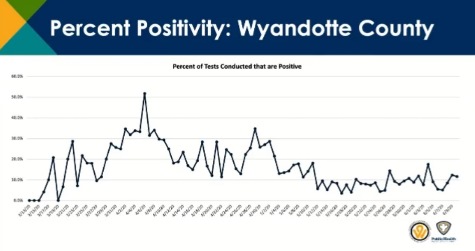
The percent positivity rate has been declining in Wyandotte County, Dr. Greiner said, It measures the percentage of positive tests among all who are tested. The positivity rate is still high in Wyandotte County compared to others, he said.
“We’re seeing a lot of cases and deaths in long-term nursing care,” he said.
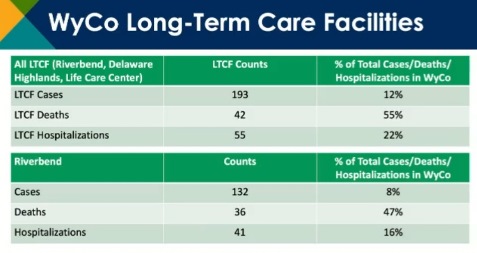
Forty-five percent of the deaths in the United States and 53 percent in Kansas have come from long-term care facilities.
There have been three outbreaks in long-term care facilities in Wyandotte County, according to Dr. Greiner.
Together, they accounted for 193 cases, 42 deaths and 55 hospitalizations.
Riverbend Post-Acute Care facility accounted for 132 cases, 36 deaths and 41 hospitalizations. It was 47 percent of the total deaths in Wyandotte County.
“We feel like we’re doing a better job,” Dr. Greiner said about the long-term care facilities here. They are doing cyclical testing every so often, he said. It’s about a 10-day cycle, he added.
“Something has worked pretty well, so that we’re not as surprised,” he said.
However, they have seen a lot of surprises in meatpacking operations and employer-based outbreaks, he added.
Dr. Jessica Kalender-Rich, who was recently selected to serve on the White House Coronavirus Commission for Safety and Quality in Nursing Homes, said CDC guidance suggests that they should test all the nursing home staff every week. Counties need to make individual decisions on their capacity to test, the prevalence and the need to test before making reopening decisions that would allow individuals to visit the nursing homes again.
Outbreaks are now smaller because they are doing a better job of testing the whole facility once there’s one positive, and then containing all the positive cases together, and continuing to test in order to keep people separate and safer, Dr. Kalender-Rich said.
Dr. Hawkinson said the rate of positivity of health care workers is basically the same as the community. A study in Belgium found the highest risk of health care workers having a positive test is from a household contact with COVID-19, he said. He said they are able to protect the health care workers while they are in the hospital.
Dr. Greiner said some of Wyandotte County’s numbers are driven by social determinants of health. Lower income, closer living conditions and chronic stress can contribute to health problems.
Dr. Kalender-Rich said larger and urban nursing care facilities are more likely to have larger and worse outbreaks, according to studies. Some urban facilities have a lower age of residents because of cumulative effect of comorbidities, she said.
Dr. Hawkinson said early treatment is helpful for COVID-19. They are doing studies for remdesivir and plasma at the KU Health System, he said.
On the national level, an announcement on Tuesday sparked a rally in the stock market when it was stated that dexamethasone has reduced the rate of deaths by about one-third among hospitalized COVID-19 patients, according to international study results. The FDA also recently announced it was taking hydroxychloroquine off the list of medications for emergency use for COVID-19.
On the question of treatment, Dr. Stites said people could go to the emergency room if they are having shortness of breath and other symptoms. Dr. Greiner urged people to stay in touch with their primary health care providers to know when they should come in to be checked.
Dr. Kalender-Rich said the nursing homes are taking care of the minor levels of the disease, and if it becomes more severe, patients could be sent to the hospital.
In answer to a question, Dr. Greiner said he and Dr. Kalender-Rich are on a task force that will evaluate when long-term care patients can meet with their families again. In a future phase, they may be able to hold outdoor meetings with patients and their families, the doctors said.
In a news release later Tuesday, the Unified Government Health Department officials stated that they were hoping to see the number of rolling averages of positive cases decrease. However, during the past week, those averages started to go up, which is concerning, according to Elizabeth Groenweghe, chief epidemiologist for the Health Department.
“We think people are seeing more places reopening and are so eager to get back to a sense of normalcy, that they are starting to relax on safety measures,” Dr. Greiner said in the news release. “We understand that being under public health restrictions has been difficult for everyone, but COVID-19 is still very much a threat to our community. It is still vitally important that we all take steps like wearing cloth face coverings when in public, practicing social distancing, covering coughs and sneezes, and washing hands frequently. We are also counting on area businesses to ensure that appropriate precautions are in place to protect their workers and customers.”
“At this point, we are set to stay in Phase 3 of reopening until at least June 22,” Dr. Greiner said in the news release. “If we continue to see our numbers going up, we will likely have to stay in Phase 3 for a while longer.”
Dr. Greiner added, “If we see a large enough spike, we will, unfortunately, have to consider going back to a more restrictive phase.”
The Health Department, according to a spokesman, wants to reiterate the importance of precautions to our local businesses and community members.
Checklist for businesses
Most businesses can reopen at some capacity during Phase 3, and it is the responsibility of those businesses to keep their employees and visitors as safe as possible from COVID-19. Businesses need to:
• Ensure social distancing (at least six feet) between individuals and groups who do not share a household. This may include steps such as installing partitions between patrons or employees, modifying employee work areas or work schedules, or marking spots on the floor six feet apart where people will be waiting in line.
• Ask that employees wear masks or cloth face coverings and encourage customers to do the same.
• Educate employees on how to properly wear a mask (ensuring it covers both the nose and mouth at all times).
If employees become sick, especially with COVID-19 symptoms, they should stay home except to get tested for COVID-19 at a local testing site.
Businesses can learn more in the Wyandotte County COVID-19 Business Toolkit, available at wycokck.org/COVID-19. They can also get business-related COVID-19 questions answered by calling 3-1-1.
Wearing masks or cloth face coverings
The Health Department strongly recommended that anyone over the age of 2 wear a cloth face covering while in public. Health Department staff offered tips about masks and cloth face coverings:
• It is important to wear a mask or cloth face covering appropriately. This means that it must cover both your mouth and nose.
• Do your best to not touch your mask or your face. If you need to adjust your mask, clean your hands with soap and water or hand sanitizer before and after touching your mask.
• Cloth face coverings that you can make with items around your home are effective at helping reduce the spread of COVID-19. You do not need a surgical mask or other medical-grade mask, and it is best to reserve those supplies for healthcare workers.
• Learn about cloth face covering recommendations, including how to make your own mask at home, at cdc.gov/COVID19
• The primary purpose of mask is to protect others in case you may be carrying the virus, even if you don’t have symptoms. If everyone wears masks, they are all helping protect one another, and especially protect those most vulnerable to serious illness.
Wearing a mask is not a substitute for social distancing. The combination of different safety precautions is how to best stop the spread of COVID-19, according to the Health Department spokesman.
Social distancing
• Maintain a distance of at least six feet between yourself and anyone who does not live in your household.
• You may need to modify aspects of your routine to do this, such as not carpooling with people outside of your household.
• Remember to also wear a mask or cloth face covering for additional protection, even when you are six feet apart.
Social gatherings
• Under Phase 3, social gatherings are limited to no more than 45 people.
• In addition to keeping the number of people to no more than 45, social distancing of six feet or more should be maintained.
If you get sick or are exposed to COVID-19, get tested
• You should get tested for COVID-19 if:
o You develop any symptoms of COVID-19, such as:
o Fever
o Dry cough
o Shortness of breath – difficulty breathing
o Headache
o Chills
o Muscle – body aches
o Runny nose
o Sore throat
o Diarrhea
o New loss of taste or smell
Testing also is recommended for those who have been exposed to COVID-19 through close contact (within six feet for at least ten minutes) with someone who has tested positive or through association with a known outbreak.
Testing is available for free to people who live or work in Wyandotte County at multiple community locations, including the Health Department and a rotating weekly schedule of “pop-up” sites coordinated by the Wyandotte County Health Equity Task Force. Find the latest testing schedule and locations at wycokck.org/COVID-19 or by calling 3-1-1.
The pop-up testing sites on Thursday, June 18, are 11 a.m. to 2 p.m., the Holy Name of Jesus Parish, 16 S. Iowa St., Kansas City, Kansas; and from 10 a.m. to 1 p.m., Roswell Church of Christ, 2900 Roswell Ave., Kansas City, Kansas.
Residents may be able to spread the virus without symptoms
Local health Officials reminded Wyandotte County residents that asymptomatic spread may be possible, and that safety precautions should be taken even if they do not have symptoms.
“Even if you don’t have symptoms right now, you may still be able to infect others,” said Dr. Erin Corriveau, deputy medical officer with the Health Department. “Recently, someone from the World Health Organization mistakenly said that asymptomatic spread is unlikely, then quickly retracted the statement because there is not adequate scientific evidence to support that claim. Unfortunately, this misinformation spread widely. We are still learning more about this virus every day, and we certainly don’t have the data to back up a claim that the virus doesn’t spread without symptoms. More importantly, we do see evidence that people who develop symptoms can be infectious up to two days before their symptoms start. This is why it is so important for everyone to wear masks and practice social distancing, even if they feel well.”
For additional data and resources on COVID-19 in Wyandotte County, visit wycokck.org/COVID-19 or call 3-1-1.
To view the KU doctors’ news conference, visit https://www.facebook.com/kuhospital/videos/1439310846269479/?tn=%2Cd%2CP-R&eid=ARAVeuJ9pdoOI60HIf4dBTBpKn7_IHgWjGj7eaQTcKn2CsyfE05k9AcdP0UQ5SpnzSf4o58b_pUFzoU0
The state’s COVID-19 test page is at https://www.coronavirus.kdheks.gov/280/COVID-19-Testing
The UG’s COVID-19 information page is at https://alpha.wycokck.org/Coronavirus-COVID-19-Information.
Wyandotte County is currently under Phase 3. See covid.ks.gov.
The state plan’s frequently asked questions page is at https://covid.ks.gov/wp-content/uploads/2020/05/Reopening-FAQ_5.19.2020_Final.pdf.
Test sites are listed on the Wyandotte County website at https://wyandotte-county-covid-19-hub-unifiedgov.hub.arcgis.com/pages/what-to-do-if-you-think-you-have-covid-19.
The CDC’s COVID-19 web page is at https://www.cdc.gov/coronavirus/2019-nCoV/index.html.
